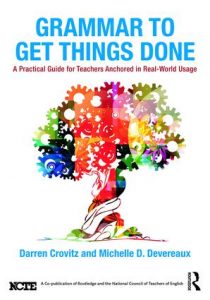This post was written by NCTE members Darren Crovitz and Michelle Devereaux, authors of Grammar To Get Things Done: A Practical Guide for Teachers Anchored in Real-World Usage, a co-publication of Routledge and NCTE.
 Mention grammar to students, and you’ll likely get a response somewhere between fear and loathing. Beyond the rare fans of sentence diagramming, teachers usually react with similar unease or frustration.
Mention grammar to students, and you’ll likely get a response somewhere between fear and loathing. Beyond the rare fans of sentence diagramming, teachers usually react with similar unease or frustration.
Grammar is a thorny thing. In our work with preservice English teachers, we’ve spent a lot of time trying to figure out how best to help our candidates navigate some realities of grammar and usage:
- controlling the surface features of their own communication to meet professional expectations,
- building a comfortable working knowledge of common grammatical concepts, and
- putting strategies into practice for teaching grammar effectively with their future students.
There are no easy solutions here. Each of these objectives is an ongoing, incremental project that requires consistent metacognitive attention from teachers and teacher candidates. This is work that, realistically, takes years.
Most of us know what the research indicates: that teaching grammar in isolation isn’t effective. The alternative is usually teaching “grammar in context,” which often translates to students considering the moves that writers make in classroom texts. Meanwhile, using students’ own communication as the basis for constructive language study may sound like a fruitful possibility, but it’s also a daunting prospect for teachers with a hundred or more students. There are few models for having such conversations in the classroom.
Every day, young people use language in unique and sophisticated ways to get what they want and need. Can we leverage these moments to help them take up and practice specific grammar moves intentionally? Can we help them bring their subconscious language knowledge to their conscious language use? Can we show them how grammatical fluency can help them achieve real, immediate goals in the world? For example, consider the following:
- You just had a fender-bender driving Grandpa’s vintage car. In your phone call to him, use passive voice to de-emphasize your responsibility.
- At your school’s homecoming pep rally, you’ll have a few moments on the microphone to motivate the crowd to support the football team in tonight’s big game. Use compound sentence structure and parallelism to create a classic rallying cry.
- What’s the best way to end a relationship? Your friend Yulia was just going to send a text to her soon-to-be-ex Casey, but after talking it over with you, she’s decided that a face-to-face conversation is more respectful. It won’t be easy, but Yulia is determined to make a clean break. Help your friend prepare for her heart-to-heart with Casey by planning out what she’s going to say. Try to use some simple sentences intentionally—be direct and clear—without being cruel.
As English teachers, we have a responsibility to include discussions of power, society, and identity when we teach language. Ultimately, language is a form of power: shaping reality, changing minds, getting things done. Grammar instruction, then, should include conversations about using language purposely but also ethically. This is grammar at work in our lives, and—perhaps—what grammar and language study should be in the classroom.
Darren Crovitz is professor of English Education at Kennesaw State University. He is co-author of Inside Out: Strategies for Teaching Writing, 4th ed. (Heinemann, 2013). Darren and Michelle will be presenting at the NCTE Annual Convention Saturday, 11:00 a.m. to 12:15 p.m. I.45 Grammar to Get Things Done, Room B405.
Michelle Devereaux is assistant professor of English Education at Kennesaw State University. She is the author of Teaching About Dialect Variations and Language in Secondary English Classrooms (Routledge, 2015) and the winner of the 2016 CEE Richard Meade award.
